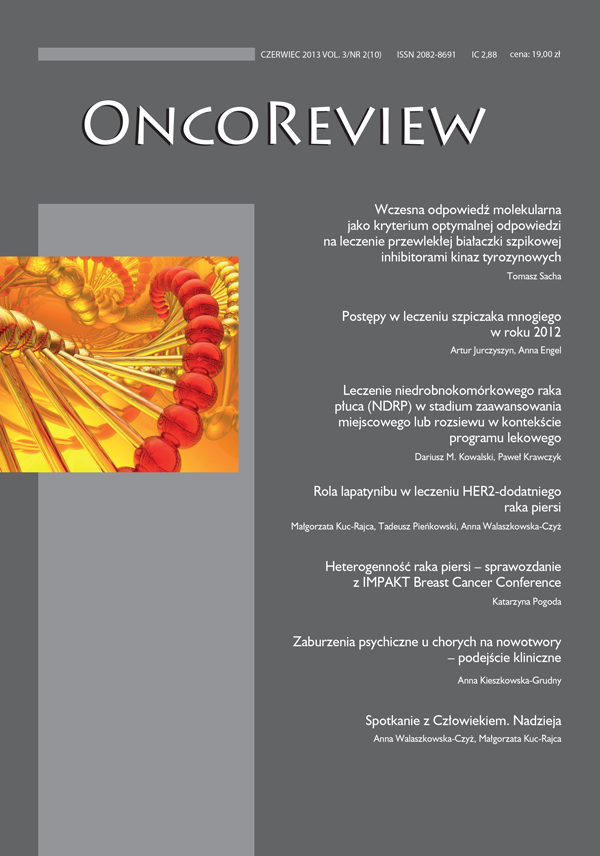Mental disorders in cancer patients – clinical approach Review article
Main Article Content
Abstract
Cancer patient is struggling not only with the primary disease, but also is exposed to emotional states that at unfavorable conditions and heavy burden can lead to depression, increased anxiety, and in consequence cause various mental disorders. Good cooperation between the medical oncologist and the patient, as well as medical oncologist with a psychiatrist and/or psychotherapist can help in the correct diagnosis of these disorders and the implementation of treatment tailored to the patient’s general state and the severity of these symptoms. The paper presents background information on depression and anxiety in cancer patients as well as treatment options.
Downloads
Metrics
Article Details

This work is licensed under a Creative Commons Attribution-NonCommercial 4.0 International License.
Copyright: © Medical Education sp. z o.o. This is an Open Access article distributed under the terms of the Attribution-NonCommercial 4.0 International (CC BY-NC 4.0). License (https://creativecommons.org/licenses/by-nc/4.0/), allowing third parties to copy and redistribute the material in any medium or format and to remix, transform, and build upon the material, provided the original work is properly cited and states its license.
Address reprint requests to: Medical Education, Marcin Kuźma (marcin.kuzma@mededu.pl)
References
2. Ducrocq F., Vaiva G., Cottencin O., Molenda S., Bailly D.: Post-traumatic stress, post-traumatic depression and major depressive episode: literature. Encephale 2001; 27(2): 159-68.
3. Smith M.Y., Redd W.H., Peyser C., Vogl D.: Post-traumatic stress disorder in cancer: a review. Psycho Oncology 1999; 8(6): 521-537.
4. Alderfer M.A., Navsaria N., Kazak A.E.: Family functioning and posttraumatic stress disorder in adolescent survivors of childhood cancer. J. Fam. Psychol. 2009; 23(5): 717-25.
5. Naderi M., Firouzkoohi Moghadam M., Hamzenejad M., Emamdadi A., Karami H.: Post-traumatic stress disorder and related factors in parents of children with cancer in South-East of Iran. Iran Red Crescent. Med. J., 2012; 14(12): 776-81.
6. Carney R., Freedland K. Miller G., Jaffe A.: Depression as a risk factor for cardiac mortality and morbidity. A review of potential mechanisms. J. Psychosom. Res. 2002; 53: 897-902.
7. Rudisch B., Nemeroff C.: Epidemiology of comorbid coronary artery disease and depression. Biol. Psychiatry 2003; 54: 227-240.
8. Ziółkowska-Kochan M., Pracka D.: Depresja po udarze mózgu. Psychiatria w Praktyce Ogólnolekarskiej 2003; 3(4): 203-208.
9. Wichowicz H.M., Sławek J., Derejko M. et al.: Factors associated with depression in Parkinson‘s disease: a cross-sectional study in a Polish population. Eur. Psychiatry 2006; 21: 516-520.
10. Nowicki A., Rządkowska B.: Depresja i lęk u chorych z nowotworami złośliwymi. Współ. Onkol. 2005; 9(9): 396-403.
11. Potyralska M.M., Krawczyk A.M.: Depresja u osób z cukrzycą typu 2 – współwystępowanie, implikacje kliniczne i terapeutyczne. Wiad. Lek. 2007; 60(9-10): 449-453.
12. Krzyżanowski J.: Depresja. Wydawnictwo Medyk Sp. z o.o., Warszawa 2002: 19.
13. Gupta S., Saha P.K., Mukhopadhyay A.: Prevalence of hypothyroidism and importance of cholesterol estimation in patients suffering from major depressive disorder. J. Indian. Med. Assoc. 2008; 106: 240-242.
14. Bergevin P., Bergevin R.: Recognising depression. Am. J. Hospice Pall. Care 1995; 12: 22-3.
15. Pyter L.M., Pineros V., Galang J.A. et al.: Peripheral tumors induce depressive-like behaviors and cytokine production and alter hypothalamicpituitary-adrenal axis regulation. Proc. Natl. Acad. Sci. USA 2009; 106: 9069-9074.
16. Block S.D.: Assessing and managing depression in the terminally ill patient. ACP-ASIM End-of-Life Care Consensus Panel. American College of Physicians – American Society of Internal Medicine. Ann. Intern. Med. 2000; 132(3): 209-218.
17. Kieszkowska-Grudny A.: Dystres i depresja u chorych na nowotwory – diagnostyka i leczenie. Oncoreview 2012; 4(8): 246-251.
18. Wise M.G., Rundell J.: The American Psychiatric Publishing Textbook of Consultation-Liaison Psychiatry: Psychiatry in the Medically Ill. American Psychiatric Pub. 2002: 1160.
19. Roth A.J., Holland J.C.: Psychiatric complications in cancer patients. W: Current Therapy in Hematology Oncology. 5th ed. Brain M.C., Carbone P.P. (red.), Mosby-Year Book, Inc. St. Louis, Mo 1995: 609-18.
20. Richelson E.: Pharmacokinetic drug interactions of new antidepressants: a review of the effects on the metabolism of other drugs. Mayo Clin. Proc. 1997; 72(9): 835-47.
21. Preskorn S.H.: Clinically relevant pharmacology of selective serotonin reuptake inhibitors. An overview with emphasis on pharmacokinetics and effects on oxidative drug metabolism. Clin. Pharmacokinet. 1997; 32(supl. 1): 1-21.
22. Jin Y., Desta Z., Stearns V. et al.: CYP2D6 genotype, antidepressant use, and tamoxifen metabolism during adjuvant breast cancer treatment. J. Natl. Cancer. Inst. 2005; 97(1): 30-9.
23. Grassi L., Riba M.: W: Depressive Disorders in Physical Illness. Riba M., Grassi L. (red.). World Psychiatric Association, Geneve 2008; 67-81, 200.
24. Li M., Fitzgerald P., Rodin G.: Evidence-based treatment of depression in patients with cancer. J. Clin. Oncol. 2012; 30(11): 1187-96.
25. Kieszkowska-Grudny A., Grudny J., Sierko E. et al.: Role of psychological and emotional factors in cancer related fatigue (CRF) syndrome in advanced NSCLC patients undergoing palliative chemotherapy. Advances in Palliative Medicine 2010; 9: 81-86.
26. Stark D., Kiely M., Smith A., Velikova G., House A., Selby P.: Anxiety disorders in cancer patients: their nature, associations, and relation to quality of life. J. Clin. Oncol. 2002; 20(14): 3137-48.

